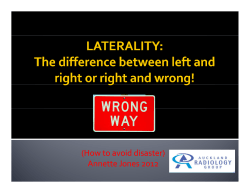
“THE CORE” PART TWO:
“THE CORE” PART TWO: How to test the CORE You may have had your “CORE” tested at one point in time. Perhaps this test involved the number of sit-ups you could perform before fatiguing. Perhaps this test was performed with a metronome to help pace your efforts. I’m here to say this testing method of the core DOES not evaluate the “core” according to how we defined the function of the core which is to transmit forces, while maintaining neutral spine - see part one. The important concept here is that the spine is tested in a neutral spine position. Sit-ups test your capacity to perform trunk flexion. This exercise does not measure the capacity to resist against forces that perturb neutral spine position. So you may be asking yourself what exercises exist that test your ability to test your ability to maintain neutral spine position. To evaluate the core involves testing several factors. 1. capacity / endurance 2. the magnitude of load “CORE” musculature can resist (direction specific) 3. motor control of the spine during movement The plank and the side bridge are excellent exercises to test your ability to maintain a neutral spine position. A great deal of research has been performed using these exercises. Much of the work has been conducted with occupational workers for the purposes of identifying a risk factor for Prepared by: Dr. Thomas Lam | www.FITSTORONTO.com | 1 low back pain. Few studies have been performed with athletes. Based on the work, by Stuart McGill a standard has been developed where a given level of safety against low back pain has been proposed to be 120s for a plank and 90s for a side bridge. Workers with scores below these levels are at increased risk for low back pain. This work has been adopted by the fitness and the strength and conditioning community erroneously. Some trainers have clients and athletes performing these exercises for three times the standard, with the belief that it will increase protection against low back pain and it will improve performance in athletes. This is absolutely incorrect. John Gray reports that beyond 2 standard deviations above these standards does not give any addition protection against low back pain or does not aid in any performance improvements – 180s plank and 120s side bridge. Therefore why perform an exercise if it does not improve performance or reduce injury risk? Tradition and misguided interpretation are an answer. do we need to do? Just to remind you of the key points we discussed in part one about how the “CORE” relates to the body – in particular 5Site Integrity. 1. 2. 3. 5. 6. 7. 8. The body is made of links / chains where motor control and muscular capacities are necessary to maintain proper area relationships. If one area is compromised all areas become compromised. Violations lead to injuries and suboptimal performance The longer the violation the more difficult it is to correct Correct anatomical relationship lead to improved joint positions, more efficient movement patterns, reduced risks of injury, and improved performance Violations are most likely due to deficiencies in capacities as opposed to balance problems. Fatigue or poor work capacity will effect an athletes ability to maintain 5 site integrity While we looking at five key areas other abnormalities may occur More is not always better. In many cases having a sufficient amount is all you need. No more is necessary. The point is this; to evaluate the core requires a battery of tests to evaluate the various functions and qualities of the core. These are as described earlier are: I hope you are wondering, if sit-ups don’t test the CORE appropriately, and the plank and side bridge tests capacity / endurance, which only helps to a point then what else 1. capacity / endurance 2. the magnitude of load “CORE” musculature can resist (direction specific) Prepared by: Dr. Thomas Lam | www.FITSTORONTO.com | 2 3. motor control of the spine during movement No single test can properly evaluate the core. The battery of tests we use to evaluate the core as we define; as the body’s ability to control against spine movement are: This battery of tests gives us a much better detail of how the body works to transmit forces. I will explain more about these tests in the next issue, along with testing standards and some of our preliminary findings to date. Thanks for reading. Prepared by: Dr. Thomas Lam | www.FITSTORONTO.com | 3
© Copyright 2025





















